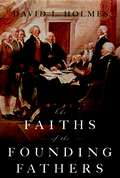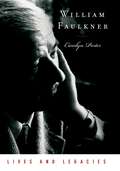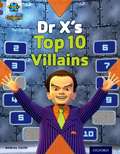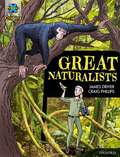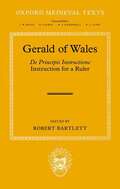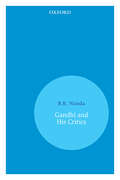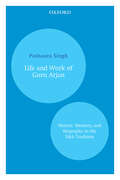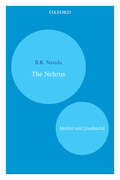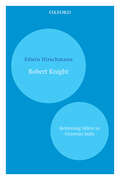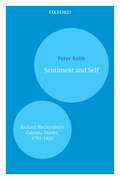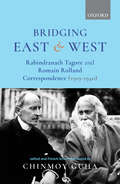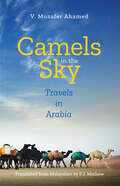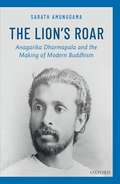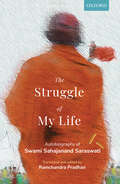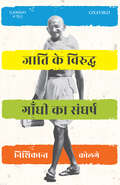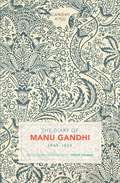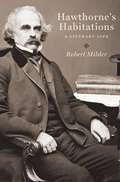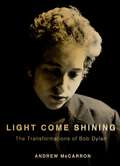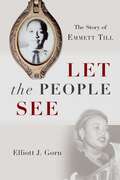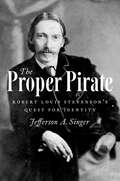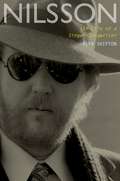- Table View
- List View
The Faiths of the Founding Fathers
by David L. HolmesIt is not uncommon to hear Christians argue that America was founded as a Christian nation. But how true is this claim? In this compact book, David L. Holmes offers a clear, concise and illuminating look at the spiritual beliefs of our founding fathers. He begins with an informative account of the religious culture of the late colonial era, surveying the religious groups in each colony. In particular, he sheds light on the various forms of Deism that flourished in America, highlighting the profound influence this intellectual movement had on the founding generation. Holmes then examines the individual beliefs of a variety of men and women who loom large in our national history. He finds that some, like Martha Washington, Samuel Adams, John Jay, Patrick Henry, and Thomas Jefferson's daughters, held orthodox Christian views. But many of the most influential figures, including Benjamin Franklin, George Washington, John and Abigail Adams, Jefferson, James and Dolley Madison, and James Monroe, were believers of a different stripe. Respectful of Christianity, they admired the ethics of Jesus, and believed that religion could play a beneficial role in society. But they tended to deny the divinity of Christ, and a few seem to have been agnostic about the very existence of God. Although the founding fathers were religious men, Holmes shows that it was a faith quite unlike the Christianity of today's evangelicals. Holmes concludes by examining the role of religion in the lives of the presidents since World War II and by reflecting on the evangelical resurgence that helped fuel the reelection of George W. Bush. An intriguing look at a neglected aspect of our history, the book will appeal to American history buffs as well as to anyone concerned about the role of religion in American culture.
William Faulkner: Lives and Legacies (Lives and Legacies Series)
by Carolyn PorterIn this newest volume in Oxford's Lives and Legacies series, Carolyn Porter, a leading authority on William Faulkner, offers an insightful account of Faulkner's life and work, with special focus on the breathtaking twelve-year period when he wrote some of the finest novels in American literature. Porter ranges from Faulkner's childhood in Mississippi to his abortive career as a poet, his sojourn in New Orleans (where he met a sympathetic Sherwood Anderson and wrote his first novel Soldier's Pay), his short but strategically important stay in Paris, his "rescue" by Malcolm Crowley in the late 1940s, and his winning of the Nobel Prize. But the heart of the book illuminates the formal leap in Faulkner's creative vision beginning with The Sound and the Fury in 1929, which sold poorly but signaled the arrival of a major new literary talent. Indeed, from 1929 through 1942, he would produce, against formidable odds--physical, spiritual, and financial--some of the greatest fictional works of the twentieth century, including As I Lay Dying, Sanctuary, Light in August, Absalom, Absalom! and Go Down, Moses. Porter shows how, during this remarkably sustained burst of creativity, Faulkner pursued an often feverish process of increasingly ambitious narrative experimentation, coupled with an equally ambitious thematic expansion, as he moved from a close-up study of the white nuclear family, both lower and upper class, to an epic vision of southern, American, and ultimately Western culture. Porter illuminates the importance of Faulkner's legacy not only for American literature, but also for world literature, and reveals how Faulkner lives on so powerfully, both in the works of his literary heirs and in the lives of readers today.
Dr X's Top Ten Villains
by Andrea SmithProject X Origins is a ground-breaking guided reading programme for the whole school. Action-packed stories, fascinating non-fiction and comprehensive guided reading support meet the needs of children at every stage of their reading development. Find out more about fictional villains in Dr X's Top Ten Villains. Each book contains inside cover notes that highlight challenge words, prompt questions and a range of follow-up activities to support children in their reading.
Project X Origins: Dark Red Book Band, Oxford Level 17: Time: What's Your Time?
by Claire LlewellynRead about sporting icons who compete across the globe to be the fastest in their field in What's Your Time?. Find out how athletes are timed and about world records, both good and bad. This book is part of Project X Origins, a ground-breaking guided reading programme for the whole school.
Project X Origins Graphic Texts: Dark Blue Book Band, Oxford Level 16: Great Naturalists
by James Driver Craig Phillips Dave GibbonsProject X Origins Graphic Texts can help children to reach higher standards in comprehension. Join Charles Darwin as he witnesses Jane Goodall's ground-breaking discoveries about chimpanzees and finds out about Mary Anning's first fossilized Plesiosaur find, among others
Gerald Of Wales: De Principis Instructione (Oxford Medieval Texts)
by Robert BartlettGerald of Wales was an ecclesiastic, a servant and critic of the Angevin kings, and a prolific and vitriolic writer. Born in Pembrokeshire of mixed Norman and Welsh blood in the middle years of the twelfth century, he was appointed archdeacon of Brecon in 1175, but that was the highest office he attained, despite his indefatigable efforts in the years 1198-1203 to become not merely bishop, but archbishop, of St Davids. His death was reported in 1223. His Instruction for a Ruler (De principis instructione) is of interest for three main reasons: it provides a detailed and violently partisan account of the last days of Henry II of England; it is full of miscellaneous but valuable stories and anecdotes (such as the account of the discovery of the tomb of Arthur and Guinevere, and the legend of the destruction of the Picts); and it is a monument to the literary culture of a highly educated writer at the heart of the twelfth-century Renaissance.
Gandhi and His Critics
by B.R. NandaThe book explores the evolution of Gandhi's ideas, his attitudes toward religion, the racial problem, the caste system, his conflict with the British, his approach to Muslim separatism and the division of India, his attitude toward social and economic change, his doctrine of nonviolence, and other key issues.
Life and Work of Guru Arjan: History, Memory, and Biography in the Sikh Tradition
by Pashaura SinghA comprehensive study of the life and work of Guru Arjan (1563–1606), the fifth Guru of the Sikhs, this volume reconstructs his life based on history, memory, tradition, and mythic representation. Pashaura Singh focuses on the major influences that shaped Guru Arjan's thought. He discusses the socio-political conditions that moulded the Guru's life, inspiring him to become one of the greatest religious leaders of the world. Presenting a systematic analysis of Guru Arjan's teachings, the author examines the Guru's role as leader of the growing Sikh Panth. The book discusses major institutional developments and the formation of the Sikh canon during the Guru's reign. It also explores the circumstances surrounding the Guru's martyrdom and the subsequent impact on the crystallization of the Sikh Panth
The Nehrus: Motilal and Jawaharlal
by B.R. NandaMotilal Nehru and Jawaharlal Nehru are both prominent Indian men in their own right. Motilal is known as a widely successful civil lawyer and a popular political figure, while Jawaharlal made his mark as a firm nationalist leader and possible heir of the Mahatma. This book serves as a discussion of Motilal’s life and achievements, and looks into the first four decades of Jawaharlal’s life. It shows that while the father–son tandem played different roles in the nationalist struggle of India, their close emotional bonds helped them influence each other. Their story can be combined with that of the Indian freedom movement. The book covers a number of important events in the lives of the Nehrus—from Motilal’s childhood in Agra, Jawaharlal’s acceptance into Trinity College, and Jawaharlal’s entry into the political arena, to the father–son conflict over the changing political atmosphere in India. This book also takes a look at several notable individuals who play important roles in Motilal and Jawaharlal’s lives. These include Annie Besant, the leader of the Home Rule movement, and Mahatma Gandhi, the fierce fighter for India’s independence.
Robert Knight: Reforming Editor in Victorian India
by Edwin HirschmannRobert Knight, the principal founder and the first editor of Times of India, Mumbai and Statesman, Kolkata has hardly ever been mentioned in accounts of British India and omitted from biographical dictionaries. Using remote letters, crumbling newspapers, and obscure official archives, this book presents the first historical biography of the pioneering editor. It also outlines the history of two of today's leading newspapers. Knight fought for a press free of government restraint or intimidation. An ardent critic of colonial rule, he made the press—the 'fourth estate'—a part of the political process in India. This volume documents the making of the reformer editor, taking us through his London background and start in Bombay; the first editorship and creation of the Times of India; the ill-fated move to Calcutta, the launching of the Statesman; the London venture; and finally the mature editor coming to terms with the empire. Against a backdrop of key events of Indian history from 1857 onwards, Robert Knight's editorial responses, and his personal life are all lucidly intertwined in this biography. Edwin Hirschmann elaborates on the connections of the world of newsprint with the colonial establishment and Indian people. He also provides a fresh approach to the Orientalism debate by deploying the narrative of an Englishman, involved in the age of the emerging public communication system.
Sentiment and Self: Richard Blechynden’s Calcutta Diaries, 1791–1822
by Peter RobbRichard Blechynden was a surveyor, architect, and builder in early colonial Bengal. This volume and its companion (Sex and Sensibility) use 80 volumes of his diaries and other archival material along with anecdotes, extracts, and stories to recreate histories of everyday life. While Sex and Sensibility deals with larger issues of sexuality, concubines, and dynamics of households in colonial Bengal, this volume deals with life in Calcutta and the re-creation of a British identity. It explores issues like interactions between Europeans and Indians; race and tolerance; laws and legal system; and establishment of colonial city and government giving a bird’s eye-view of colonial Calcutta and its dynamic society. This book will interest scholars and students of modern Indian history, gender studies, cultural studies, and British Imperialism, as well as those interested in biographies.
Bridging East and West: Rabindranath Tagore and Romain Rolland Correspondence (1919–1940)
by Chinmoy GuhaDating from 1919 to 1940, these letters and telegrams are being published for the first time in English in their entirety. They manage to capture the essence of Tagore and Rolland’s friendship in their struggle with the conflict between nationalism and human conscience. This volume also presents three important conversations the two engaged in at various points in time, as well as letters by Rathindranath Tagore and others, and lays out the journey of these two writers towards the imaging of a different world outside jingoistic politics. This correspondence presents the finest exchange of thought between the East and the West, and scripts the intellectual history of early twentieth century.
Camels in the Sky: Travels in Arabia
by V. Muzafer AhamedJourneying from the green, rain-soaked Kerala into the amphitheatre of the Sun, our traveller-journalist finds that there is no better metaphor than the desert to instil the lessons of life and death, love and hatred, thirst and water. From a single shower of rain which brings the gaaf tree back to life after a decade to the ever-shifting dunes of gold and thousand-year-old sand palaces, the mysterious poetry of the desert is everywhere on display, if one but has the eye and heart to see it. As the deserts of Nafud, Dahna, and Rub’ al Khali in Arabia both embrace and trap the travellers, the outpouring of the landscape’s longing for rivers recalls a past filled with water. This narrative describes the history, prehistory, archaeology, legends, folklore, and travails of the émigré Asian work force that tames the harsh desert as never before.
The Lion’s Roar: Anagarika Dharmapala and the Making of Modern Buddhism
by Sarath AmunugamaAnagarika Dharmapala (1864–1933) was a leading Sinhalese Buddhist reformer and national activist who ranks high among the makers of modern Buddhism. The Lion’s Roar is one of the first detailed accounts of Anagarika Dharmapala’s life and the pioneering role he played in the Sinhalese Buddhist nationalism at a time when resistance to colonial rule was mainly confined to the elite. The book explores his lifelong struggle for re-establishing Buddhist management of their own sacred places under Hindu control, particularly the Mahabodhi site in Bihar, India. Dharmapala’s association with the Bengali intelligensia, the ‘bhadralok’, and close interactions with Gandhi and Nehru in India, where he spent a greater part of his life, form an interesting part of the narration. Using a rich variety of primary sources, most importantly, Dharmapala’s diaries, the book situates his life within the socio-political and cultural ethos of Ceylon (Sri Lanka) and chronicles the zealous efforts of a Buddhist crusader and monk who wished to reform the religion in his native land and propagate it in the Western world.
The Struggle of My Life: Autobiography of Swami Sahajanand
by Ramchandra PradhanSahajanand Saraswati (1889–1950) was a man of many parts. Monk, scholar, freedom fighter, and leader of the peasant movement, he made an impact in all these spheres. His autobiography, Mera Jeevan Sangharsh (‘The Struggle of My Life’), gives an account of his life and his attempts to reform the ills besetting his country, in religion and in politics. In doing so, it sheds light on a number of significant periods in the history of India. It is, however, the tale of the nation told from the margins, not from the perspective of the English-educated, vilayat-returned nationalist. It is written by a man with humble roots who decided to improve the life of the common masses. This is an especially relevant book in these times, when the aam aadmi has become the pivot on which election campaigns are run and won. The Struggle of My Life chronicles the remarkable life of a man who lived in remarkable times.
Jaati ke Viruddh Gandhi ka Sangharsh
by Nishikant KolgeIn 1909, while still in South Africa, Gandhi publicly decried the caste system for its inequalities. Shortly after his return to India though, he spoke of the generally beneficial aspects of caste. Gandhi's writings on caste reflect contradictory views and his critics accuse him of neglecting the unequal socio-economic structure that relegated Dalits to the bottom of the caste hierarchy. So, did Gandhi endorse the fourfold division of the Indian society or was he truly against caste? In this book, Nishikant Kolge investigates the entire range of what Gandhi said or wrote about caste divisions over a period of more than three decades: from his return to India in 1915 to his death in 1948. Interestingly, Kolge also maps Gandhi's own statements that undermined his stance against the caste system. These writings uncover the 'strategist Gandhi' who understood that social transformation had to be a slow process for the conservative but powerful section of Hindus who were not yet ready for radical reforms. Seven decades after it attained freedom from colonial powers, caste continues to influence the socio-political dynamics of India, and Gandhi against caste—the battle is not over yet.
The Diary of Manu Gandhi: 1943–1944
by Tridip SuhrudManu Gandhi, M.K. Gandhi’s grand-niece, joined him in 1943 at the age of fifteen. An aide to Gandhi’s ailing wife Kasturba in the Aga Khan Palace prison in Pune, Manu remained with him until his assassination. She was a partner in his final yajna, an experiment in Brahmacharya, and his invocation of Rama at the moment of his death. Spanning two volumes, The Diary of Manu Gandhi is a record of her life and times with M.K. Gandhi between 1943 and 1948. Authenticated by Gandhi himself, the meticulous and intimate entries in the diary throw light on Gandhi’s life as a prisoner and his endeavour to establish the possibility of collective non-violence. They also offer a glimpse into his ideological conflicts, his efforts to find his voice, and his lonely pilgrimage to Noakhali during the riots of 1946. The first volume (1943–44) chronicles the spiritual and educational pursuits of an adolescent woman who takes up writing as a mode of self-examination. The author shares a moving portrait of Kasturba Gandhi’s illness and death and also unravels the deep emotional bond she develops with Gandhi, whom she calls her ‘mother’.
Hawthorne's Habitations: A Literary Life
by Robert MilderThe first literary/biographical study of Hawthorne's full career in almost forty years, Hawthorne's Habitations presents a self-divided man and writer strongly attracted to reality for its own sake and remarkably adept at rendering it yet fearful of the nothingness he intuited at its heart. Making extensive use of Hawthorne's notebooks and letters as well as nearly all of his important fiction, Robert Milder's superb intellectual biography distinguishes between "two Hawthornes," then maps them onto the physical and cultural locales that were formative for Hawthorne's character and work: Salem, Massachusetts, Hawthorne's ancestral home and ingrained point of reference; Concord, Massachusetts, where came into contact with Emerson, Thoreau, and Margaret Fuller and absorbed the Adamic spirit of the American Renaissance; England, where he served for five years as consul in Liverpool, incorporating an element of Englishness; and Italy, where he found himself, like Henry James's expatriate Americans, confronted by an older, denser civilization morally and culturally at variance with his own.
Light Come Shining: The Transformations of Bob Dylan (Inner Lives)
by Andrew McCarronBob Dylan is the prince of self-reinvention and deflection. Whether it's the folkies of Greenwich Village, the student movement of the 1960s and 1970s, Born Again Christians, the Chabad Lubavitch community, or English Department postmodernists, specific intellectual and sociopolitical groups have repeatedly claimed Bob Dylan as their spokesperson. But in the words of filmmaker Todd Haynes, who cast six actors to depict different facets of Dylan's life and artistic personae in his 2009 film I'm Not There, "The minute you try to grab hold of Dylan, he's no longer where he was." In Light Come Shining, writer Andrew McCarron uses psychological tools to examine three major turning points - or transformations - in Bob Dylan's life: the aftermath of his 1966 motorcycle "accident," his Born Again conversion in 1978, and his recommitment to songwriting and performing in 1987. With fascinating insight, McCarron reveals how a common script undergirds Dylan's self-explanations of these changes; and, at the heart of this script, illuminates a fascinating story of spiritual death and rebirth that has captivated us all for generations.
Light Come Shining: The Transformations of Bob Dylan (Inner Lives)
by Andrew McCarronBob Dylan is the prince of self-reinvention and deflection. Whether it's the folkies of Greenwich Village, the student movement of the 1960s and 1970s, Born Again Christians, the Chabad Lubavitch community, or English Department postmodernists, specific intellectual and sociopolitical groups have repeatedly claimed Bob Dylan as their spokesperson. But in the words of filmmaker Todd Haynes, who cast six actors to depict different facets of Dylan's life and artistic personae in his 2009 film I'm Not There, "The minute you try to grab hold of Dylan, he's no longer where he was." In Light Come Shining, writer Andrew McCarron uses psychological tools to examine three major turning points - or transformations - in Bob Dylan's life: the aftermath of his 1966 motorcycle "accident," his Born Again conversion in 1978, and his recommitment to songwriting and performing in 1987. With fascinating insight, McCarron reveals how a common script undergirds Dylan's self-explanations of these changes; and, at the heart of this script, illuminates a fascinating story of spiritual death and rebirth that has captivated us all for generations.
Let the People See: The Story of Emmett Till
by Elliott J. GornThe world knows the story of young Emmett Till. In August 1955, the fourteen-year-old Chicago boy supposedly flirted with a white woman named Carolyn Bryant, who worked behind the counter of a country store, while visiting family in Mississippi. Three days later, his mangled body was recovered in the Tallahatchie River, weighed down by a cotton-gin fan. Till's killers, Bryant's husband and his half-brother, were eventually acquitted on technicalities by an all-white jury despite overwhelming evidence. It seemed another case of Southern justice. Then details of what had happened to Till became public, which they did in part because Emmett's mother, Mamie Till-Mobley, insisted that his casket remain open during his funeral. The world saw the horror, and Till's story gripped the country and sparked outrage. Black journalists drove down to Mississippi and risked their lives interviewing townsfolk, encouraging witnesses, spiriting those in danger out of the region, and above all keeping the news cycle turning. It continues to turn. In 2005, fifty years after the murder, the FBI reopened the case. New papers and testimony have come to light, and several participants, including Till's mother, have published autobiographies. Using this new evidence and a broadened historical context, Elliott J. Gorn delves more fully than anyone has into how and why the story of Emmett Till still resonates, and always will. Till's murder marked a turning point, Gorn shows, and yet also reveals how old patterns of thought and behavior endure, and why we must look hard at them.
Let the People See: The Story of Emmett Till
by Elliott J. GornThe world knows the story of young Emmett Till. In August 1955, the fourteen-year-old Chicago boy supposedly flirted with a white woman named Carolyn Bryant, who worked behind the counter of a country store, while visiting family in Mississippi. Three days later, his mangled body was recovered in the Tallahatchie River, weighed down by a cotton-gin fan. Till's killers, Bryant's husband and his half-brother, were eventually acquitted on technicalities by an all-white jury despite overwhelming evidence. It seemed another case of Southern justice. Then details of what had happened to Till became public, which they did in part because Emmett's mother, Mamie Till-Mobley, insisted that his casket remain open during his funeral. The world saw the horror, and Till's story gripped the country and sparked outrage. Black journalists drove down to Mississippi and risked their lives interviewing townsfolk, encouraging witnesses, spiriting those in danger out of the region, and above all keeping the news cycle turning. It continues to turn. In 2005, fifty years after the murder, the FBI reopened the case. New papers and testimony have come to light, and several participants, including Till's mother, have published autobiographies. Using this new evidence and a broadened historical context, Elliott J. Gorn delves more fully than anyone has into how and why the story of Emmett Till still resonates, and always will. Till's murder marked a turning point, Gorn shows, and yet also reveals how old patterns of thought and behavior endure, and why we must look hard at them.
The Proper Pirate: Robert Louis Stevenson's Quest for Identity
by Jefferson A. SingerExploring the life and times of author Robert Louis Stevenson, The Proper Pirate takes readers on a psychological journey from the writer's religious and constricted upbringing to a life of imagination and wonder culminating in the South Seas island of Samoa. Drawing on contemporary theories of identity development, Jefferson A. Singer traces how Stevenson overcame Victorian dualities of piety versus passion in both his personal life and artistic works, gradually edging toward a more Modernist and complicated moral vision. This first full-length psychobiographical study of Stevenson follows the trajectory of his life, all while highlighting how key memories and conflicts within his personality shaped the narrative structure and themes of some of his most celebrated works, including: Treasure Island, Strange Case of Dr. Jekyll and Mr. Hyde, A Child's Garden of Verses, and Kidnapped. Stevenson's relationships to his parents, his wife Fanny, and circle of intimate friends also play a prominent role in this investigation of his emerging identity and artistic body of work.
The Proper Pirate: Robert Louis Stevenson's Quest for Identity
by Jefferson A. SingerExploring the life and times of author Robert Louis Stevenson, The Proper Pirate takes readers on a psychological journey from the writer's religious and constricted upbringing to a life of imagination and wonder culminating in the South Seas island of Samoa. Drawing on contemporary theories of identity development, Jefferson A. Singer traces how Stevenson overcame Victorian dualities of piety versus passion in both his personal life and artistic works, gradually edging toward a more Modernist and complicated moral vision. This first full-length psychobiographical study of Stevenson follows the trajectory of his life, all while highlighting how key memories and conflicts within his personality shaped the narrative structure and themes of some of his most celebrated works, including: Treasure Island, Strange Case of Dr. Jekyll and Mr. Hyde, A Child's Garden of Verses, and Kidnapped. Stevenson's relationships to his parents, his wife Fanny, and circle of intimate friends also play a prominent role in this investigation of his emerging identity and artistic body of work.
Nilsson: The Life of a Singer-Songwriter
by Alyn ShiptonPaul McCartney and John Lennon described him as the Beatles' "favorite group," he won Grammy awards, wrote and recorded hit songs, and yet no figure in popular music is as much of a paradox, or as underrated, as Harry Nilsson. In this first ever full-length biography, Alyn Shipton traces Nilsson's life from his Brooklyn childhood to his Los Angeles adolescence and his gradual emergence as a uniquely talented singer-songwriter. With interviews from friends, family, and associates, and material drawn from an unfinished autobiography, Shipton probes beneath the enigma to discover the real Harry Nilsson. A major celebrity at a time when huge concerts and festivals were becoming the norm, Nilsson shunned live performance. His venue was the studio, his stage the dubbing booth, his greatest triumphs masterful examples of studio craft. He was a gifted composer of songs for a wide variety of performers, including the Ronettes, the Yardbirds, and the Monkees, yet Nilsson's own biggest hits were almost all written by other songwriters. He won two Grammy awards, in 1969 for "Everybody's Talkin'" (the theme song for Midnight Cowboy), and in 1972 for "Without You," had two top ten singles, numerous album successes, and wrote a number of songs--"Coconut" and "Jump into the Fire," to name just two--that still sound remarkably fresh and original today. He was once described by his producer Richard Perry as "the finest white male singer on the planet," but near the end of his life, Nilsson's career was marked by voice-damaging substance abuse and the infamous deaths of both Keith Moon and Mama Cass in his London flat. Drawing on exclusive access to Nilsson's papers, Alyn Shipton's biography offers readers an intimate portrait of a man who has seemed both famous and unknowable--until now.
